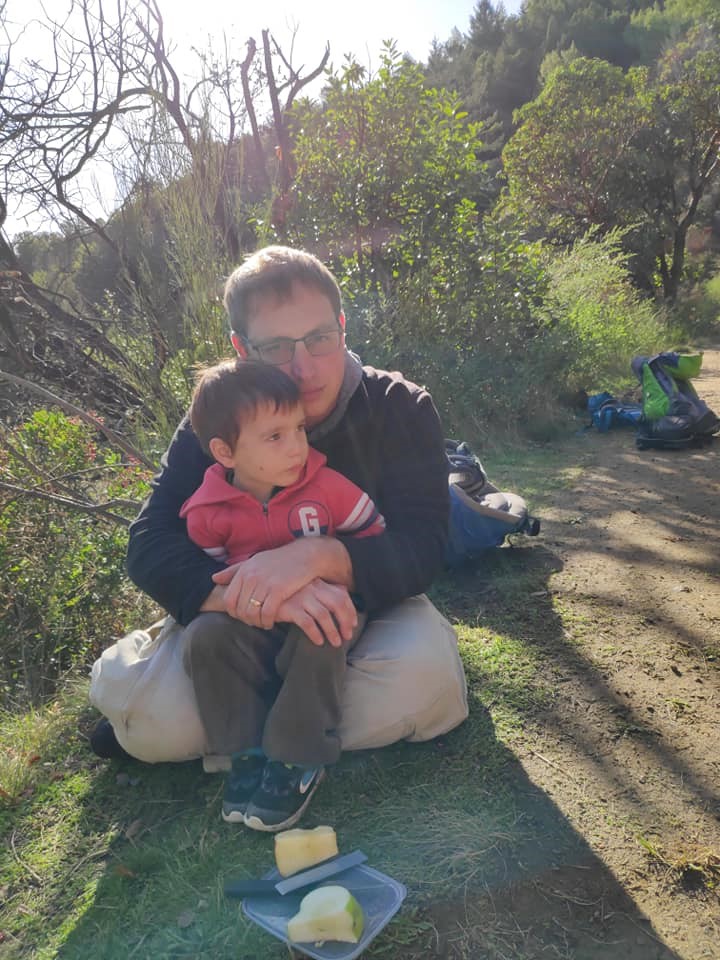A bridge between the theoretical and practical worlds
Gal Mendelson, our 2020 Israeli Postdoctoral fellow heading to Stanford University, shares his academic journey.
Twelve suitcases, six carry-ons, six backpacks, four car seats, one double seat stroller and six coats. I don’t remember how we got to the airport. It is all a blur now. A month ago we left Israel with four young kids so I could start my Postdoc position at the Stanford Graduate School of Business in January 2021. We got our Visas at the last possible minute (literally). We kept waiting for the next crisis to come along, create delays, change plans. After all, this is the year of Covid-19.

But our persistence paid off. I am writing these words in our apartment in Menlo Park, a few miles from Stanford. The big girls started going to school, the little ones will shortly begin going to preschool. We arrived to the magnificent scenery of autumn leaves falling in the streets. The swirling colors on the ground mirrored my emotions as I got my first glance of the Stanford campus. I have been preparing and waiting for this moment for a long time.

Six and a half years as an engineer in the Israeli navy, two summer internships at IBM Research and a year spent at Mellanox (now Nvidia) have taught me the importance of strong fundamental theoretical science. For anything to be practical on a large scale it should be accessible, reliable, easily deployed and easily tested. It must have a strong theoretical foundation that can only come from understanding the engineering challenge well enough and having the right theoretical tools to tackle the problem. Restricting oneself to search for what I call “theoretically-practical” solutions to problems forces one to understand the problem very well. One must identify the fundamentals of the problem to solve it efficiently.
My knowledge in Applied Probability, Stochastic Systems and Algorithms, together with my engineering experience put me in a unique position to form a bridge between the theoretical and practical worlds. Indeed, during my PhD in Electrical Engineering, I designed and analyzed practical load balancing algorithms for communication systems with different performance-cost tradeoffs. For example, on the theoretical side, I won the Informs Applied Probability Society best student paper award for developing a new theoretical tool called “sub-diffusive load balancing” to analyze load balancing systems. I applied it to several well-known systems and derived valuable new insights on their performance. On the more practical side, my dissertation, and, specifically, a new scalable consistent hashing algorithm I designed, has reached the finals, and has won an honorable mention, in the George B. Dantzig dissertation award which endows dissertations in the operation research field with strong practical contributions and potential.
Good load balancing and efficient implementation lead to better resource utilization. Too often the potential of systems is barely reached because there is not enough accessible, fundamental knowledge as to how to utilize resources efficiently. My PhD research revolved around algorithms which are data agnostic, which is the prevalent form of algorithms used in practice today. Historically, it seems to me that there are four main reasons for this approach: (1) it was widely accepted that an algorithm should be robust in the sense that it should not depend too much on the system parameters and constraints; (2) systems were generally small in size so overprovisioning them to make up for inefficiencies was preferred over investing time in optimizing; (3) systems evolved slowly, so if it worked – it worked; and (4) there was not enough data that could be used to specialize algorithms to the system they are designed for.
Clearly, many systems today are very large and evolve at a very high pace. Overprovisioning such networks at a meaningful scale incurs a large overhead. What works today may not work in a few months when the input traffic doubles. Data is abundant and collected easily and systems differ from one another substantially. So, it only seems natural that we move away from the system-independent-data-agnostic approaches and design fundamental tailored solutions that use data that result in efficient resource utilization. This is the direction I am headed towards.

I love what I do. I am passionate about learning and evolving, confronting obstacles that almost seem impossible to overcome. I love digging so deep into a problem that solving it becomes like solving a riddle. I suffer through the uncertainty, the failed attempts and doubts (oh, there are many of those!) with the belief that the breakthroughs will occur, if I only set myself in the position to allow them to happen.
For me, the most rewarding and exciting way to undergo this process is with people who I connect with. Collaborators who share my passion and, ideally, are more skillful than I am at certain aspects of the problem we are trying to solve, complement me. This is the reason I chose Professor Kuang Xu from Stanford GSB as my Postdoc host. During our very first conversation we immediately connected. It was clear that we share a passion for fundamental, meaningful research. Professor Xu’s ability to crystalize high level ideas, demonstrate their principle in accessible examples and follow through with impeccable analysis is nothing short of (in my opinion) phenomenal. Combine that with his interest in information theory and machine learning, two fields in which I am not an expert, and you get an excellent opportunity to learn and evolve. I am certain that our journey together will be exciting and productive.



